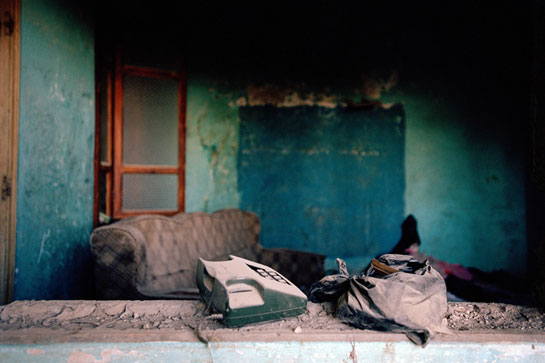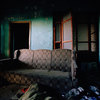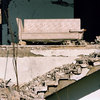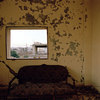A Conversation with Dalia Khamissy

After I linked to Dalia Khamissy’s work earlier this year, she emailed me, and we ended up talking about her work. Its background intrigued me, and I asked her whether I could interest her in doing an interview for the blog. (more)
Jörg Colberg: Your series “Abandoned Spaces” struck me, and they reminded me of earlier, purely fine art work, namely Jeff Wall’s The Destroyed Room and John Divola’s Zuma. The abandoned spaces you photographed look the way they look because they were bombed out - and whatever aesthetic aspect there might be in a sense is completely coincidental. Some people might even argue that making things look beautiful under such circumstances is something artists should not do - because it’s war, after all. Were you worried about the aesthetic appeal of the images somewhat masking the underlying reality?
Dalia Khamissy: Although I am very flattered by the comparison, I find it strange that my work reminds you of Wall’s and Divola’s work as I do not see the resemblance really… I just feel the 3 of us documented abandoned spaces but the visual is very different, not to talk about the situation.
I studied Photography at a Fine Arts faculty, so the aesthetic was very important in our work. We spent our years studying the work of masters of photography and those surely became “masters” because their photographs were aesthetically different than others… We studied also history of art, drawing etc. So one’s eye gets used to seeing in a different way I guess. Photography, for me, is a form of art, and I see documentary photography as an art through which photographers inform on a certain situation. An artist friend once told me the Abandoned Spaces I shot were very beautiful, they do not represent the war! But this is how I see things, I was wondering if he expected I take “ugly” images just because they would better document the war… then no one would even look at the images and I would not have done my job as a photographer.
When I was shooting, I did not even think of the results or what I would do with the images once the films developed. It was just my first documentation of the Israeli offensive on Lebanon in 2006 and I was trying to get back to my photography.
JC: Somewhat related, “Abandoned Spaces” is war photography - but unlike in the photography we get to see so often, the imagery is very different. There aren’t the usual visual cliches, and even though violence obviously took place, with no humans present it almost doesn’t look like war photography. It could have been “just” apartment fires, say. What made you create these kinds of images?
DK: I went to the bombed out regions in the south of Lebanon almost a year after the war, as I could not be there during the war, so those houses were abandoned for a long time… But this is exactly what made me create those images. In this series I was struck by the peaceful and sad spaces I found when I entered the houses and mosques; the furniture left behind witnessed of the stories of people who once lived there… I felt I knew those people; I knew their taste in furniture, colours, fabric, clothes that covered the ground etc. You imagine stories of how they lived, how they used to gather at night all together, how they laughed, argued etc… How they hid from the bombs and how they fled the war, if they ever managed to flee the war… Their spaces and lives were completely violated and I related to that, I wanted to document that. The war had turned their private spaces into public in few seconds and it was very disturbing. In a way I put myself in their shoes and I was furious. It could have been “just” apartment fires, earthquakes or any other natural disasters, but those were not, the shrapnel-pocked walls in some images are witnesses to the human violence, the walls that were completely destroyed are also signs of the war. It was shocking how many houses were completely flattened and the ones I shot here represented the survival of some, same with the human beings.
JC: Beyond the comment by your artist friend, what other reactions have you run into?
DK: Some said the same, but not in a negative way; they were more impressed by the result. They thought it was a contradiction that needed to be debated.
Some cinematographers had told me my photographs look as if they were scenes from movies, but this was not only said about the Abandoned Spaces series, but for most of my work. I think it is because I did lots of still photography for the films of my friends at university who were mostly studying cinema, and others later on.
The strangest reaction I can remember was when in June 2009 I was invited to give a workshop of Photography in Granada, an activity parallel to a film festival. I also had a solo exhibition there with the Abandoned Spaces. After the closing party of the festival, it was almost 6am and I was falling asleep sitting on the ledge. A young Spanish photographer, who had been to my exhibit earlier, asked me if I had put the telephone on the window’s ledge and if I had redecorated the houses just for the images. I tried to explain that this was really the effect of the war that happened in 2006, that if he looked closer at the telephone he would see a cobweb etc. For some reason he did not believe it or he did not understand me because of the language problem, I keep thinking of this one. I was struggling not to fall asleep and the conversation was longer than expected. I just gave up and left.
Well the point is that some people were really impressed while others did not think the images sent the correct message… But this is what it is all about at the end of the day; aesthetic is relative.
JC: In an email, you told me that you were “a photo editor for the Associated Press during the Israeli offensive on Lebanon in 2006,” that you “had no days off,” and were “working for 16 hours a day with TEN male photographers.” This sounds like such a straining experience, and I’m wondering how it affected your way of taking photos?
DK: I think they were more than TEN to be honest!! To be fair each one of us had one day off during the 34 days of the war… We did not even take the weekends off and we all worked sometimes for more than 16 hours a day… The retaliation was incomprehensible! The bombing did not stop, not even for few hours a day… It was crazy. When the Israeli army was bombarding the southern suburbs of Beirut the sound was so loud that the first time it happened I thought the bombs fell in the parking next to the offices, so imagine a month of that. I was 2 years old when the civil war started in Lebanon but the 2006 summer war was the most intense war I ever witnessed. Maybe it was also because I was directly connected to it, working as a photo editor. While during the other wars I was a teenager hiding with my family. It was indeed straining… not to forget the stress we all went through knowing that our colleagues, who were out of the office, were constantly in danger… some of them were even injured by the bombing.
I quit 4 months after the beginning of the war because I wanted to go back to my photography and document the aftermath… but I was completely destroyed. It was the first time I even tried to shoot the wars in Lebanon or their aftermaths… At some point I felt I did not want to take photos anymore, and I did not want to do the effort.
It was actually since I started working at the AP in 2005, that I started worrying that my way of seeing things would change… I am not a news or war photographer, while the AP is a news agency. I have lots of respect and admiration for news and war photographers and the work they do but it is something I am not sure I can do myself and it is a different way of seeing things; even though there are many photographers in the news agencies, whose work is closer to documentary than to news… But in 18 months working with AP, my way of seeing things surely matured, especially during the war of 2006.
I think it helped me a lot when I took some distance from the war, photography; work in general… It also helped I did not do the effort or felt obliged to document the aftermath. On my way to the south, I had no intention of shooting anything; I was just going to see what had happened personally. But when I entered those spaces, I just grabbed the camera and shot one image… I did not even finish one film that day. I thought this could be an exercise to reconcile with photography. It was… Seeing so many images during the war made me more mature… I knew what I did not want to shoot.
JC: The many war photographers notwithstanding, I’m always wondering whether we don’t need, in fact, if not a new then at least a different kind of war photography, one that is maybe less focused on the immediate effect of war and, instead, looks more at long-term consequences of war. When I saw your images I thought they were pointing into that direction, challenging the viewer in more ways than just one. Are you still working on related imagery, or has your focus shifted now?
DK: My images are completely pointing into that direction. This was my main aim when I decided to quit my job at the Associated Press. I wanted to go back to taking pictures and telling the stories of people whose lives had changed forever because of the war, especially the 2006 summer one. In a way I wanted to tell my own story with the war, during which, the country was packed with local and international media covering the daily events, but then few weeks after the war ended, they all packed their stuff and went back home to rest, while I stayed at the office working, of course with other local colleagues and very few international photographers who came each for few weeks.
In 2004, I lived on the border of Jordan-Iraq and documented the lives of some 2000 refugees who had fled Iraq after the beginning of the 2003 war on Iraq and found themselves stranded, on the border, in the middle of the desert, in two refugee camps. So I was already interested in documenting the effect of the war on people.
Recently I started working on another project related to the 1975-90 Lebanese civil war, more specifically the 17.000 missing citizens who were kidnapped during the civil war. Their parents do not even know where they are and are in continuous struggle to find them.
I also work on many projects related to women rights in the country. I taught a workshop of photography to women victims of domestic violence, which started in August and ended December 2009. The results were impressive; each woman told her story in her own way. And recently I also started working on another project related to women rights in Lebanon.
JC: Photojournalism is a field dominated by male photographers. To what extent do you think the imagery we - the general public - get to see is influenced by the fact that it’s mostly men taking these photos? Do you think if there were more women the images would be less graphic, say? Or is there really no difference?
DK: I do not see a difference in how male or female photographers take photographs and what they choose to see. I think the difference is in the way we relate to things and see them and our background as photographers.
 By
By 






